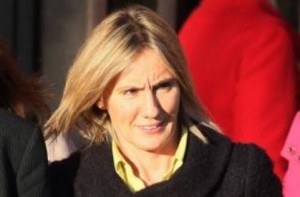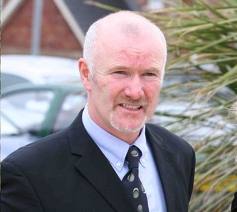‘BLACK Widow’ double killer Hazel Stewart is mounting a second bid to clear her name.
Convicted Stewart has appointed a new legal team who have sent her case to the Criminal Cases Review Commission (CCRC).
Solicitors for the former Sunday School teacher want the CCRC to refer her conviction for the murder of ex-lover Colin Howell’s wife Lesley back to the Court of Appeal.
And they also want the group which champions miscarriges of justice to overturn her conviction for killing her policeman husband Trevor Buchanan as part of the same plot.
Her lawyers also plan to introduce fresh psychiatric and psychological evidence. They also want to raise disclosure issues connected to another potential witness.
Stewart, 50, is serving a minimum 18-year jail sentence at the women’s jail in Hydebank Wood for the murders of Constable Buchanan, 32, an RUC scenes-of-crime officer, and 31-year-old Lesley Howell.
The victims were found in a fume-filled garage in Castlerock, Co Londonderry in May 1991.
A subsequent inquest said Constable Buchanan and Lesley Howell had died in a suicide plot after discovering their partners were having an affair.
They were in fact murdered before their bodies were arranged to make it look like they had taken their own lives.
Nearly two decades passed before dentist Howell, 54, suddenly confessed to both killings.
He pleaded guilty to the murders in 2010 and was ordered to serve at least 21 years behind bars.
Howell also implicated his former lover in the plot and gave evidence against her at her trial.
In March 2011, Hazel Stewart was unanimously convicted of both killings by a jury at Coleraine Crown Court.
Earlier this year the mother-of-two failed in her first attempt to overturn the verdict that she murdered Lesley Howell.
At that stage she did not proceed with a challenge to being found guilty of killing her husband.
The Court of Appeal held there was strong evidence that she was a knowing and willing participant in the plan hatched by Howell.
But newly appointed lawyers have now formally asked the CCRC to examine her case and form a view on whether there may have been a miscarriage of justice.
It could take up to two years before the body reaches a decision.
In the meantime Stewart’s legal team are also seeking to take her conviction for murdering Constable Buchanan back to the Court of Appeal.
She insists her challenge to that verdict was never abandoned. Nor was there ever any acceptance of guilt.
Her lawyer, Kevin Winters of Kevin Winters & Co Solicitors said: “The application will also touch upon outstanding disclosure issues and unresolved matters arising from the original Crown Court trial.”
“This case is somewhat novel and unusual given that it involves applications to both the CCRC and Court of Appeal on two separate murder convictions.”
At the end of the case in March 2011, trial judge Mr Justic Anthony Hart QC said that by its verdict the jury had accepted that Stewart and Howell “were in it together”.
He referred to her admissions to the police as to the part she played in the murders:
* she knew what Howell proposed to do but she did nothing beforehand to prevent the murders from being carried out;
* she knew she had to ensure her husband was sedated and admitted that she encouraged him to take a tablet that night when he said that he had difficulty in sleeping;
* she knew that she had to open the garage door to let Howell in and she did so;
* she let him into her house and did virtually nothing to dissuade him from murdering her husband;
* she knew as he went into the bedroom that he had already murdered his wife and was now going to murder her husband, yet she did nothing to prevent him;
* she provided Howell with clothes so that he could dress her husband’s body;
* she cut up and burnt the hose which Howell used to kill her husband and washed the bedclothes in order to destroy evidence;
* she concealed what had happened from the police and provided them with a false account given to her by Howell designed to mislead the police and cover up the crimes.
Mr Justice Hart said that in this case both victims were in an exceptionally vulnerable position as they lay asleep when they were murdered.
He said that Hazel Stewart’s culpability was exceptionally high because she knew in advance what Howell was going to do, and did nothing whatever to prevent the killings taking place:
“She could have told someone else, she could have told the police, and even after Lesley Howell had been murdered she could have prevented Howell from entering her house and killing her husband by any one of a number of actions, such as not opening the garage door to him, locking the door against him, waking her husband, ringing the police or alerting her neighbour to mention but a few.
“Whilst she knew Howell was murdering her husband in another room she waited and did nothing to save his life. Had she had a spark of compassion for her husband even at that late stage she would have tried to prevent his murder.”
The judge set out the aggravating factors in the case: the murders were planned in advance, Hazel Stewart helped destroy evidence of the crime by burning the hose and washing the bed covers, and she played a full part in concealing what had happened by lying to the police in her inquest statement and putting forward the story concocted by Howell.
She also benefited financially from her husband’s death but the prosecution accepted that this was not to the same extent as Howell did.
Mr Justice Hart also said he wanted to emphasise two further matters. The first was that Colin Howell accepted that he was the person who conceived and developed the plan to murder his wife and Trevor Buchanan.
As he put it at the trial: “I was the mastermind behind the plot and the plan, I was the one who had the intelligence to put the plan together”.
The judge said that Hazel Stewart is entitled to some reduction in sentence compared to his because he planned and carried out both murders and persuaded her to take part.
Secondly, Howell confessed to his crimes. Had he not done so, neither he nor Hazel Stewart would ever have been brought to justice.
Hazel Stewart however cannot claim any reduction in the minimum term in her case because she pleaded not guilty.
Mr Justice Hart said her plea of not guilty is also relevant to consideration of whether she had shown any remorse.
He said that she repeatedly lied and persisted in attempting to evade responsibility for what happened when she was questioned by the police.
It was only when confronted with the evidence of the Temazepan found in her husband’s blood during the autopsy that she started to give a more truthful account of what she knew was going to happen and what she had done.
The judge said that while she had expressed sorrow and regret during police interviews that was more about the effect of these events on herself, her children and her present husband than about the effects of the murders on all the others whose lives had been ended and blighted by the events: “I consider that she has expressed little real remorse for what she did, rather the sorrow and regret which she expressed to the police was largely because of the situation in which she found herself, and not for the events in which she played her part.”
Mr Justice Hart considered that Hazel Stewart was infatuated with Colin Howell who was “undoubtedly a charismatic, manipulative, hypocritical man with a very considerable sexual appetite”.
He believed that she was initially attracted to Howell because he offered that excitement she felt her marriage lacked:
“She then fell in love with him, and was driven by that love, and by intense sexual desire, to allow herself to be persuaded by Howell to play her part in these dreadful crimes, despite her fear that they would be caught, a part which she then concealed for many years.
“Despite her protestations to the police that she was controlled by Howell, his unchallenged evidence during the trial was that they continued their clandestine and highly active sexual relationship for several years after the murders, and even after she refused to marry him and they decided to end their relationship Stewart tried to persuade him to have sex.”
Mr Justice Hart said he had read victim impact statements from Lesley Howell’s brother, two of Howell’s children, and from several members of Trevor Buchanan’s family. He said these contain eloquent and deeply moving accounts of their sense of loss, the different ways that loss has manifested itself and their feelings of betrayal at having been deceived for so many years. He was also provided with statements from Hazel Stewart’s children Andrew and Lisa and her husband in which they asked the court to show her leniency and take into account the effect upon them of a lengthy period of imprisonment.
The judge said that tragically the consequences for Hazel Stewart’s children and her husband are part of the legacy of the conduct of both herself and Howell. Taking all of the factors into account, Mr Justice Hart concluded that the minimum term that Hazel Stewart should serve before she can be considered for release is one of eighteen years.





